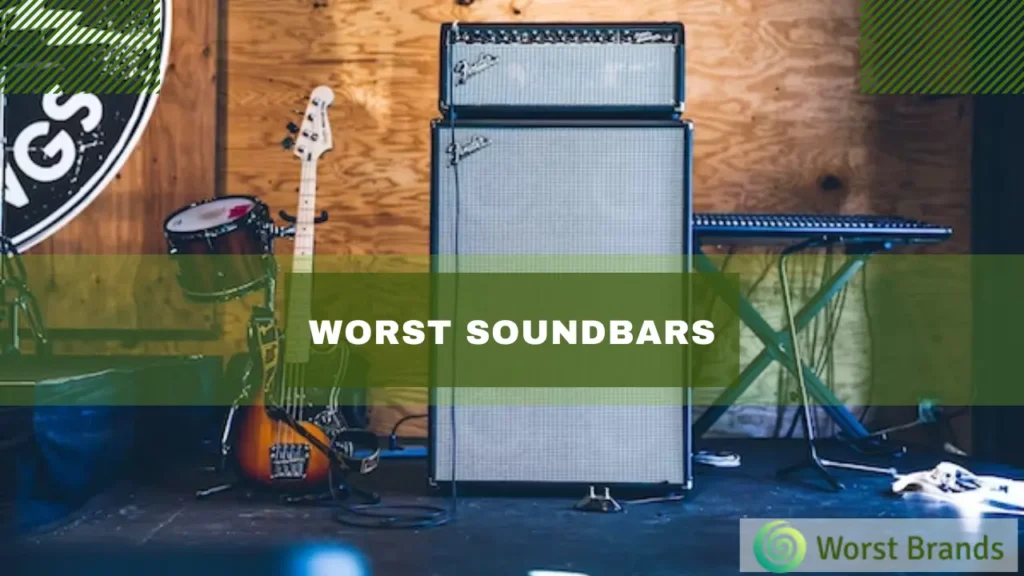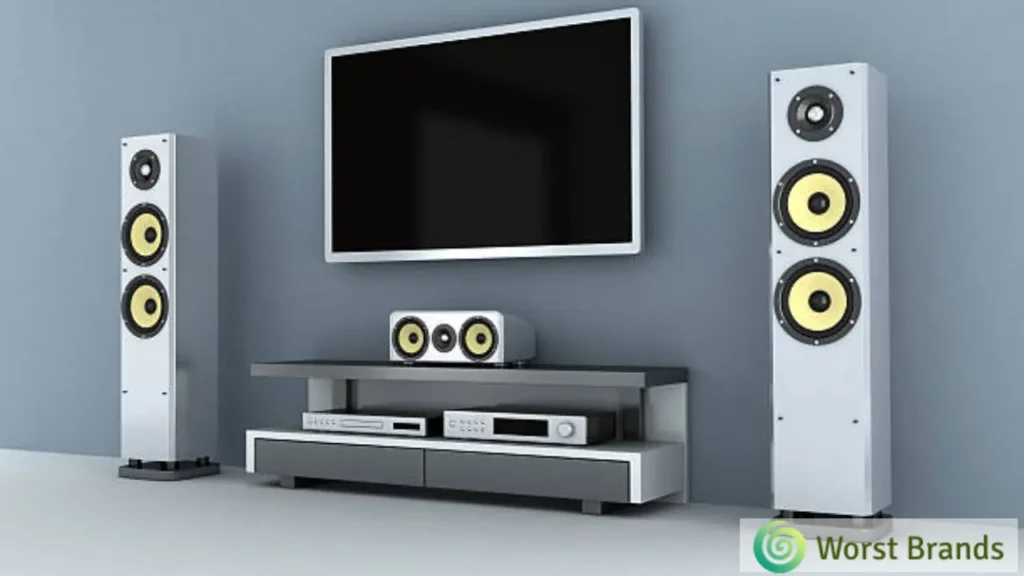We’ve all been there: eagerly setting up a new gadget, only to be let down by its performance.
Drawing from deep insights and rigorous testing, I’ve compiled the list of worst soundbars that, sadly, don’t hit the right notes.
As a tech reviewer, trust me when I say that steering clear of these might just save your next movie night or jam session. Ready to delve into the nitty-gritty of soundbars to avoid? Let’s start.
From poor audio quality to inconsistent performance, the worst soundbars include Panasonic SC-HTB688, Kogan KASBD5123HA, LG S95QR, Samsung Q990C, and a few others.

Table of Contents
Worst Soundbars
Let’s dive deep and see why these reputable brands fall into this category.
1. Panasonic SC-HTB688
The Panasonic SC-HTB688 can surely be enticing to the eye, especially for those venturing into the soundbar world for the first time.
The built-in subwoofer promises depth and richness that one might expect. But in reality, while you might feel the deep undertones, the richness tends to fizzle out.
Those sharp, high notes we crave? Often, they come out thin, almost hollow.
This creates an imbalance in sound dynamics, causing the bass to sound jumpy and unpredictable.
Furthermore, regarding functionality, the remote control design falls short. An unintuitive interface paired with clumsy buttons makes for a less-than-smooth experience.
2. Kogan KASBD5123HA
Now, to the Kogan KASBD5123HA. This reminds me of the record players I encountered a while back. At $299, this poor-quality soundbar left me wishing I had stuck to my TV’s built-in speakers.
Sound clarity, range, and immersion are basic prerequisites. Sadly, it seems to defy these expectations in all the wrong ways.
Beyond basic stereo audio, its voice quality falls flat, often struggling to differentiate between nuanced sound layers.
And while adding a sub and rear speakers might sound like a bargain, they hardly justify the compromised audio quality.
The end product? An output that feels more restricting than expansive.

3. LG S95QR
With around $2000 price tag, you’d expect the LG S95QR to be top-notch.
And while it manages to deliver satisfactory results in some domains like music and voice clarity, its performance wavers when it comes to cinema audio.
For users, this can be quite a letdown. Surprisingly, crucial features like a 3.5mm AUX input and audio delay adjustments are missing.
But the real shocker? A standby energy consumption rate that feels more wasteful than worthy of a premium product.
4. Samsung Q990C
When I invested in the Samsung Q990C soundbar, expectations were naturally high, given Samsung’s reputation. However, the experience was underwhelming.
Promising an enriched audio ambiance with front, side, and up-firing speakers, the sound often came across as disjointed.
Especially when attempting to sync with a Samsung TV via the Q Symphony feature. For a flagship product, this lack of harmony was surprising.
The audio delivery was inconsistent while it boasts advanced audio technologies like DTS:X and Dolby Atmos.
The high frequencies often felt muffled, and the bass wasn’t as punchy as one would expect from a premium soundbar.
The “Tap Sound” function, exclusive to Samsung phone users, further added to the list of limitations.
For a product positioned as a flagship, such brand exclusivity felt unnecessarily restrictive.
Despite its connectivity features, the soundbar often struggled to maintain a stable connection on Bluetooth and Wi-Fi.
Frequent dropouts during crucial cinematic moments or favorite songs were a letdown.
In short, the Q990C, despite its premium label and pricing, is among the worst soundbars.
5. Polk Magnifi Mini

I admired the Polk Magnifi Mini, especially with its crisp vocals and punchy bass.
But these moments were fleeting. As the audio progresses, there’s an apparent inconsistency.
The highs, mids, and lows don’t always converge harmoniously, leading to a somewhat jarring experience.
Tack on a remote requiring frequent reference to the manual and power consumption on the higher end.
It became clear that this model, while having potential, is among the bad soundbars to avoid.
6. Sony HTX8500
Lastly, the Sony HTX8500 is a prime example of how one exceptional feature doesn’t compensate for a lackluster overall performance.
Yes, its standby energy efficiency is commendable, almost a benchmark.
But delve into the primary purpose of a soundbar: audio delivery, and you’ll find it hovering around the average mark.
The audio doesn’t quite ‘ pop, ‘ whether it’s blaring rock music, intense movie sequences, or simple dialogues.
Additionally, the remote, an essential accessory, feels more like an afterthought with its borderline functionality.
Wrapping Up
Navigating the world of soundbars can feel like a sonic adventure. While many promise cinematic sound and ground-breaking technology, some fall flat.
The difference between a captivating movie night and a disappointing audio experience often lies in your choice of soundbars.
Just like exploring the guitar manufacturers or piccolo brands, it’s about more than just names; it’s about genuine quality and user experience.
Given the surplus of options available, dodging the worst soundbars is crucial.
Always prioritize your listening needs to ensure you make the best choice for your ears.
Christopher Evans is a Mechanical Engineer and is a distinguished expert in tire and electronic appliance testing with over 15 years of experience. Holding certifications like Automotive Tire Service (TIA) and Certified Appliance Professional (CAP). He is also a member of the the American Society of Mechanical Engineers (ASME) and has significantly contributed to safety standards and testing protocols in both industries. Evans is a respected speaker and award recipient.
